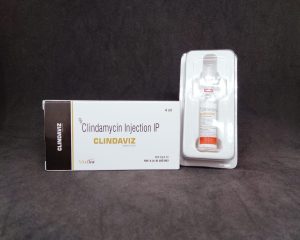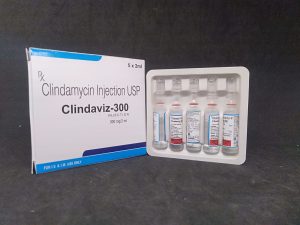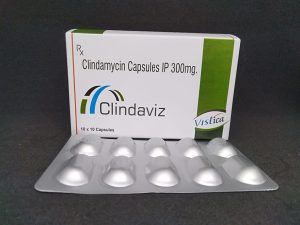CRITICAL CARE PCD FRANCHISE COMPANY
CRITICAL CARE PCD FRANCHISE FOR CLINDAMYCIN
We at Vistica Lifesciences come up with Critical Care PCD Franchise for critical care injectables including higher antibiotics and other products. Clindamycin is one of the products available for critical care pcd franchise. Clindamycin is an effective antibiotic which is helpful in the treatment of number of bacterial illnesses. Clindamycin (semisynthetic derivative) was developed from Lincomycin (a natural antibiotic from actinobacterium streptomyces lincolnensis) and introduced on the market in 1966 and included in the World Health Organization’s list of essential medicines.

The organisms which are affected by this medication are gram positive as well as gram negative pathogens
| Aerobic Gram Positive Bacteria | |
| Staphylococcus | Streptococcus |
| Pneumococcus | |
| Anaerobic Gram Negative Bacteria | |
| Bacteroides | Fusobacterium |
| Prevotella | Capnocytophaga canimorsus |
Pseudomonas, Legionella, Haemophilus influenzae and Moraxella (aerobic gram negative bacteria) they are resistant to clindamycin whereas clindamycin is always first-line drug of choice in case of Capnocytophaga canimorsus.
Clindamycin can be administered through parenteral route, orally through mouth in the form of capsule and can be applied topically on the outer skin. If it is administered through intra muscular route it is given without diluting whereas in case of intra venous route it must be diluted before administration.
Clindamycin has been created by Vistica Lifesciences and is available in the following strengths and dosage forms for the purpose of critical care pcd franchise.

| BRAND NAME | COMPOSITION | PACKING |
| CLINDAVIZ INJ | Clindamycin 150mg/ml | 4ML |
| CLINDAVIZ-300 | Clindamycin 150mg/ml | 5 * 2ML |
| CLINDAVIZ CAPSULE | Clindamycin 300MG | 10*10 |

Both these injection can be used for intramuscular as well as intra venous route. Clindamycin is soluble in water.
Vistica Lifesciences has developed a Critical Care PCD Franchise for critical care injectables that contain stronger antibiotics.
Mechanism of action
The mechanism of action is similar to macrolides and chloromephenicol that is the reason it can not be given simultaneously as antagonism may appear. Generally clindamycin is bacteriostatic (aims to suppress the growth of bacteria), however at higher concentration is shows bactericidal action (aims to kill the bacteria). Similar to macrolides, it works by inhibiting bacterial protein synthesis through inhibiting ribosomal translocation. It binds to the rRNA
of 50S ribosome unit of bacteria, and then with oxazolidinone, pleuromutilin and macrolide antibiotics it gets overlapped and this binding is reversible. Clindamycin is considered to be more effective as compared to lincomycin.
Medicinal uses & indications
Clindamycin have number of therapeutic indications which are as follow
Dental Infection
Malaria
Septicemia/ sepsis (blood poisoning due tobacteria)
Bone & joint infection (specifically caused by staphylococcus aureus)
Endometritis (Inflammation/ irritation in the lining of uterus)
Pelvic Cellulitis (parmetrium infection which is a connective tissue adjacent to the uterus) also called parametritis.
Skin & skin structure infection
Bronchitis
Pneumonia
Empyema (pus pockets collected inside body cavity)
Clindamycin is considered to be effective for multidrug resistant p. falciparum malaria in combination with quinine where tetracyclines are containdicated. In case of hypersensitivity to penicillin, clindamycin will be prescribed to treat infection that is caused by susceptible aerobic bacteria.
Side Effects
Clindamycin adverse drug reaction have only been reported on a very small number of occasions. Diarrhea, nause, vomiting, pseudomembranous colitis, abdominal pain, abdominal cramps, or rashes are some of the sideeffects. Over 1% of persons experience these side effects. Clindamycin may give metallic taste in both intravenously and orally, if taken in high dose. The side effects reported with topical administration are itching, burning, erythema (skin rash due to foam, lotion, and solution), scaliness, oiliness, dryness or peeling of skin. These reactions are experienced by over 10% of people.
Sometimes fungal infection may appear in vaginal application. Consult your doctor or health care practitioner if any of the above mentioned or any other effect appears.
The reason for resistance to clindamycin is usually due to the modification inside the 23S ribosomal RNA (Ribonucleic acid) Cross resistance between clindamycin and lincomycin is complete, and due to similarities in their binding sites, it may also exist between clindamycin and macrolide antibiotics (e.g. erythromycin).
Oral bioavailability is generally appears to be about complete which is about 90%. The volume of distribution throughout the body is wide calculated between 43 – 74 L even it has included bone but do not distribute to cerebrospinal fluid. In the serum it primarily bound to alpha 1-acid glycoprotein in the protein Clindamycin protein binding varies by concentration, ranging from 60 to 94 percent.
The drug mentioned above should be taken only on the prescription by a qualified doctor or a pharmacist.
